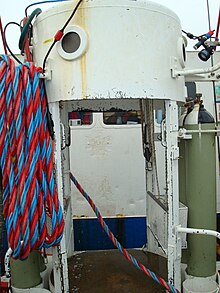Diving bell
A diving bell is a rigid chamber used to transport divers to depth in the ocean, for the purpose of performing work, such as the installation of pylons for bridges, tunnels, and underwater viaducts. The most common types are the wet bell and the closed bell.
The wet bell is a cable-suspended chamber, open at the bottom like a moon pool structure, that is lowered underwater to operate as a base or a means of transport for a small number of divers. The pressure of the water keeps the air trapped inside the bell. They were the first type of diving chamber. Unlike a submarine, the diving bell is not designed to move under the control of its occupants, nor to operate independently of its tether.
The closed bell is a sealed chamber, which may be used for mixed gas bounce diving and for saturation diving. This form of bell locks on and off the chamber where the divers live, by way of a closed door sealing the divers in at pressure. Once on the surface, the bell is mated with the chamber system and the space in between is pressurized to enable the divers to make a seal and transfer through to the chamber which is at the same pressure. In saturation diving the bell is merely the ride to and from the job, and the chamber is the living quarters. If the dive is relatively short (a bounce dive), decompression can be done in the bell in exactly the same way it would be done in the chamber.
The diving bell is one of the earliest types of equipment for underwater work and exploration. Its use was first described by Aristotle in the 4th century BC: "...they enable the divers to respire equally well by letting down a cauldron, for this does not fill with water, but retains the air, for it is forced straight down into the water." According to Roger Bacon, Alexander the Great explored the Mediterranean on the authority of Ethicus the astronomer. In 1535, Guglielmo de Lorena created and used what is considered to be the first modern diving bell.
In 1616, Franz Kessler built an improved diving bell.
In 1658, Albrecht von Treileben was permitted to salvage the warship Vasa, which sank in Stockholm harbor on its maiden voyage in 1628. Between 1663-1665 von Treileben's divers were successful in raising most of the cannon, working from a diving bell.
...
Wikipedia

